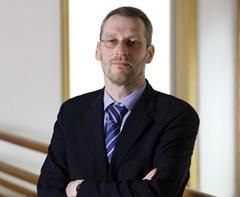Assessing the economic impact: Edgar Morganroth
 Strategic Investment Board advisor Edgar Morganroth considers how to measure returns from infrastructure investment. Prioritisation is key in tight fiscal times.
Strategic Investment Board advisor Edgar Morganroth considers how to measure returns from infrastructure investment. Prioritisation is key in tight fiscal times.
“The lawnmower approach to cutting our capital budgets might be expedient but it’s certainly not a good solution,” Edgar Morganroth told agendaNi’s seminar on infrastructure investment. “It’s very highly flawed. We should try and use our scarce resources in those areas where we get the best return.”
Prioritisation was an important running theme throughout his address, given the expected 37-40 per cent cut in capital spending over the next four years.
Investment is frequently linked to creating jobs for builders but, as Morganroth reminded the audience, this only has a short-term impact.
Research by SIB suggests that £1 million of construction investment can create 10- 30 jobs, depending on how labour intensive a project is. Refurbishment of social housing is a good example.
Construction has a further indirect effect on suppliers, as materials are needed, and an induced effect on spending “if it’s only to buy the breakfast roll in the morning”. Ultimately, though, these are all temporary.
Economists are more interested in the longer-term benefits i.e. how infrastructure shapes the economy’s productive capacity.
“Growth is not automatic. Some people think it will just happen but it won’t. What we have to do is invest,” he commented. “Firms invest and grow their businesses that way. As a government, you try and invest in human capital, innovation and infrastructure.”
Evidence on infrastructure’s macro- economic impact within the UK, while scarce, indicates returns are higher than in many other OECD members. The UK had, for many decades, invested less than other countries.
None of the academic literature seen by him had mentioned Northern Ireland. At a personal level, he had found real problems when searching for local data: “It’s easier to do research in Vietnam than it is in Northern Ireland and that’s a fact. It is very, very hard to find statistics.”
It was clear that investment allowed government to provide public services more efficiently.
To take an educational example: “You can have hundreds of schools but they’re all only half full or you could have a smaller number, all filled to capacity. That makes a big difference to the overheads that you have to cover with your revenue expenditure.”
The economic impact did not tell the whole story. A playground may have “very significant social returns” but would not make money.
Not all infrastructure was created equal. Morganroth explained that investments which deal with specific capacity constraints have the highest return, sometimes “well in advance” of private business investments as they unlocked the benefits of the wider network.
Zero returns were also possible. Haiti built a grand presidential palace, which collapsed in the January earthquake, and the money would have been better spent elsewhere. “Social housing doesn’t really score any differently to presidential palaces,” he added.
In other areas, such as education, buildings were not the most important factor. The quality of a teacher mattered more than the quality of the building, unless that building was very basic.
Research conducted by him for the European Commission indicated that a 1 per cent increase in infrastructure stock increased output by 0.25 per cent on average. Northern Ireland’s assets were estimated at £39 billion in the 2007 asset register so this level of investment could produce a £75 million increase in gross value added.
The Executive also had to consider non- economic objectives e.g. social inclusion. Morganroth therefore preferred multi- criteria analysis, used to prioritise public investment programmes in the Republic. This assesses all bids against a common set of criteria based on a government’s objectives and the established principles of public economics.
Value did not necessarily equal to cost. Electricity networks were a natural monopoly so building a second one would not add value. If too many roads were built, as had happened in Belgium, the return fell.
“You can’t just keep on increasing your investment in a particular area and hope to get the same return,” he commented. “In fact, at some point [the] return will be negative because you have to raise this money and it has an opportunity cost: you could use it somewhere else.”





